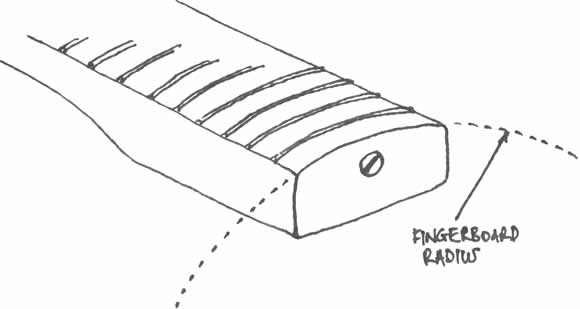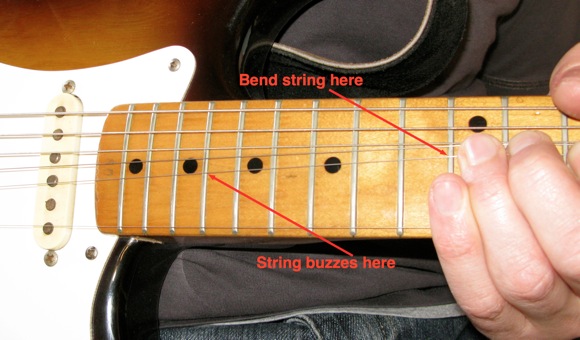How To Fix Buzzing And Choking String Bends On Fender Guitars
You’re a millionaire playboy guitarist with a vintage Fender or you’re just someone with one of many current or past Fender originals and reissues.
Whatever the case, you’re finding that those big blues bends that you love doing are buzzing or, worse still, choking-out completely and dying. Your guitar plays fine and buzz-free the rest of the time but as soon as you go for a nice, soulful, bent note, it buzzes or chokes.
Annoying.
Possibly more annoying is when I tell you that there’s a good chance it’s just a limitation of the design.
Let me explain. As you probably know, most guitar fingerboards are radiused. That is, they have a slight curve (from bass to treble sides) as if the fingerboard were cut from a cylinder. This is mainly a comfort thing – it’s easier for a human hand to fret on a slightly curved fingerboard. See the image below for an illustration of what I mean.

Some fingerboards are more curved than others. That is, the radius changes. And, on many Fenders, the amount of fingerboard curve, or the radius, is 7.25”.
The advantage of a 7.25” radius is that it’s very comfy to play on – especially to fret chords. The disadvantage is that when you bend a string more than a tone or so, the frets further up the neck get in the way and choke-out/kill the note or the note buzzes.

How can I fix my choking string-bends?
It depends. If you’re someone who doesn’t bend notes often or who generally does small bends, you might not need to do anything.
If your bent notes are choking or buzzing on your 7.25” fingerboard however, you can try to adjust the action selectively. Basically what we’ll do is to ‘flatten’ the radius down at the bridge by raising the action of your top E and B string. This compensates (slightly) for the board’s radius and it may be enough that you can get away with your string bending. You’ll probably want to raise them so they’re as high as, or even higher than the G and D strings.
This isn’t really ideal so, if raising the action doesn’t get you all the way there, or if you don’t want to do it, a good luthier should be able to improve matters and help stop bent strings buzzing with some creative fret-dressing.
Just don’t expect miracles.
Are there alternatives to a 7.25” radius fingerboard?
It may be that your style of playing just can’t get on with a 7.25” radius neck. There are alternatives. Fender have plenty of models with a 9.5” radius. This is close enough to the 7.25” to feel similar but it usually takes care of the bent-string issues. Of course, as mentioned, there are plenty of other radius boards out there by Fender and other manufacturers.
What are popular guitar fingerboard radii?
- 7.25” or 7-1/4” as we’ve discussed is the usual radius for vintage and many vintage-reissue Fenders.
- 9.5” or 9-1/2” is often used on newer Fenders like the American Standard.
- 10” is frequently used for guitars fitted with Original Floyd Rose systems.
- 12” is the usual Gibson electric radius.
- Flatter radii (14”, 16”, 20”) are usually used on contemporary, rock, guitars like some Ibanez and Jackson instruments.
- For completeness, it’s worth noting that most classical guitars have a completely flat fingerboard with no radius at all.
A lot of contemporary guitars come with a ‘compound’ radius in which the radius flattens as it goes up the neck – it might start in the 1st position with a 7.25” radius and gradually flatten to a 14” or 16” radius by the time it reaches the 22nd or 24th fret. if you imagined the fingerboard in the diagram above to be cut from a cylinder, imagine a compound board to be cut from a cone and you’ll be in the ball park.
Compound radii are popular on ‘rockier’ guitars made to shred. Lots of Martin’s however, also have a compound radius.
Some Additional Information On Fingerboard Radius Issues
Also, to add to the confusion, some boards that should have a consistent radius along their necks don’t. Due to factory errors, or problems during a previous refret, a neck may have a fingerboard that changes radius along its length. If this is causing problems, you may need to discuss it with a good guitar tech or luthier.

